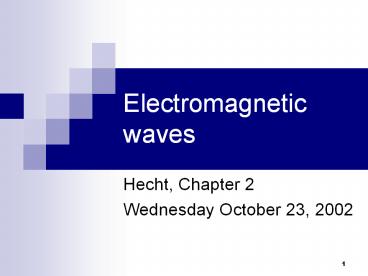Electromagnetic waves - PowerPoint PPT Presentation
Title:
Electromagnetic waves
Description:
Electromagnetic waves Hecht, Chapter 2 Wednesday October 23, 2002 Electromagnetic waves: Phase relations Thus E and B are in phase since, requires that Irradiance ... – PowerPoint PPT presentation
Number of Views:324
Avg rating:3.0/5.0
Title: Electromagnetic waves
1
Electromagnetic waves
- Hecht, Chapter 2
- Wednesday October 23, 2002
2
Electromagnetic waves Phase relations
- Thus E and B are in phase since,
- requires that
E
k
B
3
Irradiance (energy per unit volume)
- Energy density stored in an electric field
- Energy density stored in a magnetic field
4
Energy density
Now if E Eosin(?tf) and ? is very large We
will see only a time average of E
5
Intensity or Irradiance
In free space, wave propagates with speed c
c ?t
A
In time ?t, all energy in this volume passes
through A. Thus, the total energy passing through
A is,
6
Intensity or Irradiance
Power passing through A is,
Define Intensity or Irradiance as the power per
unit area
7
Intensity in a dielectric medium
In a dielectric medium,
Consequently, the irradiance or intensity is,
8
Poynting vector
Define
9
Poynting vector
For an isotropic media energy flows in the
direction of propagation, so both the magnitude
and direction of this flow is given by,
The corresponding intensity or irradiance is then,
10
Example Lasers
?o 8.854 X 10-12 CV-1m-1 (SI units)
Laser Power 5mW
Spot diameter Intensity (W/m2) Electric field magnitude (V/m)
2 mm 1.6 X 103 1.1 X 103
20 µm (e.g. focus by lens of eye) 1.6 X 107 1.1 X 105
2 µm 1.6 X 109 1.1 X 106
Same as sunlight at earth
Near breakdown voltage in water
nb. Colossal dielectric constant material
CaCu3Ti4O12 , ? 10,000 at 300K
Subramanian et al. J. Solid State Chem. 151, 323
(2000)
11
Reflection, Transmission and Interference of EM
waves
12
Reflection and Transmission at an interface
Normal Incidence Two media characterized by v1,
v2
incident
transmitted
reflected
1
2
13
Reflection and Transmission at an interface
- Require continuity of amplitude at interface
- f1 g1 f2
- Require continuity of slope at interface
- f1 g1 f2
- Recall u x vt
14
Reflection and Transmission at an interface
Continuity of slope requires,
or,
15
Reflection and Transmission at an interface
- Integrating from t -? to t t
- Assuming f1(t -? ) 0
- Then,
16
Amplitude transmission co-efficient (?)
Medium 1 to 2
Medium 2 to 1
17
Amplitude reflection co-efficient (?)
At a dielectric interface
18
Phase changes on reflection from a dielectric
interface
n2 gt n1
n2ltn1
Less dense to more dense e.g. air to glass
More dense to less dense e.g. glass to air
? phase change on reflection
No phase change on reflection
19
Phase changes on transmission through a
dielectric interface
Thus there is no phase change on transmission
20
Amplitude Transmission Reflection
For normal incidence
Amplitude reflection
Amplitude transmission
Suppose these are plane waves
21
Intensity reflection
Amplitude reflection co-efficient
and intensity reflection
22
Intensity transmission
Intensity transmission
and in general
R T 1
(conservation of energy)
23
Two-source interference
What is the nature of the superposition of
radiation from two coherent sources. The classic
example of this phenomenon is Youngs Double Slit
Experiment
Plane wave (?)
P
S1
y
?
x
a
S2
L
24
Youngs Double slit experiment
Assumptions
- Monochromatic, plane wave
- Incident on slits (or pin hole), S1, S2
- separated by distance a (centre to centre)
- Observed on screen L gtgt a (L- meters, a mm)
- Two sources (S1 and S2) are coherent and in phase
(since same wave front produces both as all
times) - Assume slits are very narrow (width b ?)
- so radiation from each slit alone produces
uniform illumination across the screen
25
Youngs double slit experiment
- slits at x 0
- The fields at S1 and S2 are
Assume that the slits might have different width
and therefore Eo1 ? Eo2
26
Youngs double slit experiment
What are the corresponding E-fields at P?
Since L gtgt a (? small) we can put r r1
r2 We can also put k1 k2 2?/?
(monochromatic source)
27
Youngs Double slit experiment
The total amplitude at P
Intensity at P
28
Interference Effects
- Are represented by the last two terms
- If the fields are perpendicular
- then,
- and,
In the absence of interference, the total
intensity is a simple sum
29
Interference effects
- Interference requires at least parallel
components of E1P and E2P - We will assume the two sources are polarized
parallel to one another (i.e.
30
Interference terms
where,
31
Intensity Youngs double slit diffraction
Phase difference of beams occurs because of a
path difference!
32
Youngs Double slit diffraction
- I1P intensity of source 1 (S1) alone
- I2P intensity of source 2 (S2) alone
- Thus IP can be greater or less than I1I2
depending on the values of ?2 - ?1 - In Youngs experiment r1 r2 k
- Hence
- Thus r2 r1 a sin ?
r1
r2
a
r2-r1































